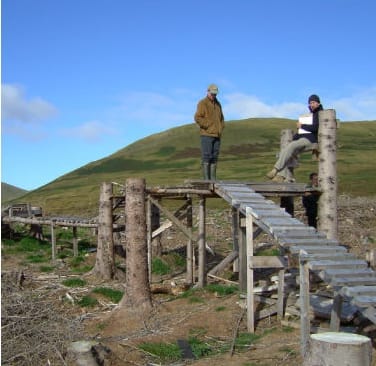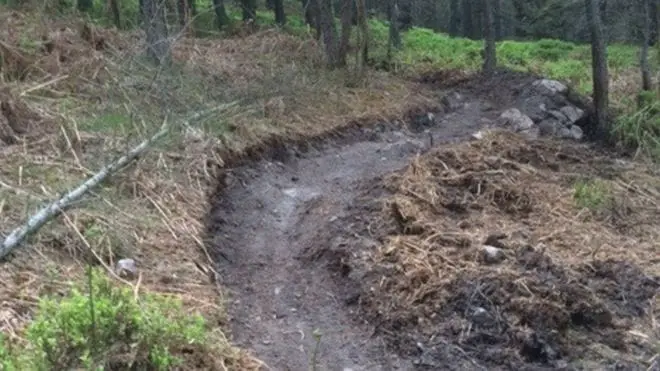In the news this week is Scottish Land & Estates, who have spoken out against DIY trailbuilding (they even made it onto the BBC, complete with an inflammatory headline). Mountain bikers have shown a range of reactions ranging from “fight the power” to “go legit”.

Scottish Land & Estates are of course talking about landowner liability, in which they’re theoretically on the hook if someone builds a canyon gap on their property then someone gets hurt trying to send it. After (so to speak) digging around for a while, the dividing line seems to be built features such as drops and jumps raising a duty of care for landowners, rather than all trails creating landowner liability, though the original article is far from clear on this. In fairness, they do point to a positive example of a landowner recognising the demand of mountain bikers using their land:
“Golspie, which had experienced footpaths being more heavily used by mountain bikers. In response to the demand, new signage was erected to focus access takers onto certain routes on the estate.
“Proposals were also brought forward for a purpose-built mountain biking facility, which was developed through a community company, Highland Wildcat. Since Highland Wildcat was established in 2005, over 18km of trail has been constructed at a cost of £600,000.”
This isn’t a bad example, but it is over a decade old, and they also omit that the £600,000 Highland Wildcat spent on it came entirely from grants, the community and local businesses.
In this round of the discussion, most people seem to be averting their eyes from the Tweed Valley, where many unsanctioned trails have later become official trails, been used to host EWS (Enduro World Series) races, and turned the valley into an international destination for mountain bikers. Of course, some advocacy organisations probably have to ignore unsanctioned trail building out of necessity and respectability.
Scotland is packed with interesting cases when it comes to land use and ownership. Everyone has heard of the right to roam, but there have been other changes to the law in the past twenty years with the aim of opening up access to more people, making things more equitable and creating greater business opportunities too. One such change is the Community Asset Transfer (C.A.T.), whereby a group who can demonstrate a public interest can apply for purchase or compulsory purchase of land – one such C.A.T. is currently in progress for the trail centre planned for the Durris Forest near Aberdeen.
Some other factoids we learned recently: 60% of Scotland is owned by 0.002% of the population, and apparently some of that ownership is through shell companies, which means it can be difficult or even impossible to find out who the landowner is. Perhaps this is why some riders feel justified in building unsanctioned trails, which echoes Chris Porter’s recent opinion that it’s just democracy in action. Other mountain bikers on social media are saying all of this brings our sport into disrepute though. Where do you stand?






unsanctioned trails are illegal. The right to roam in Scotland doesn’t mean digging trails. Digging trails can result in land management problems like drainage/erosion.
The Land Reform (Scotland) Act 2003 allows us mtbers to ride the land, not dig it up.
I’m with Poah, with one variation. Should a trail (foot, bike, canoe etc) become used and ‘wear in’ (yes I know that’s also erosion), we need a slight fuzziness of approach. The only time I’ve interfered with a trail is to increase drainage or chuck a couple of flat rocks onto a heavily worn section. Eldest_oab however seems intent on some trailbuilding, despite my protests, and we have had to negotiate a couple of places where he can – one of which just outside Dunblane sports 15′ doubles of at least 5 years standing already, so seemed ‘OK’…
The best solution would be to ditch the landowner liability.
Scotland has embraced mountain biking and land owners are seeing the benefits. If they weren’t aware of a trail etc I doubt they could be found negligent. The issue is they could still face a lawsuit as many will seek compensation and tface the cost of defending themselves. If they were aware, didn’t make the trail safe or remove it and some one was injured then neglegence could be apportioned. Many mountain bikers may say they are aware of the risks and wouldn’t seek compensation but look what happened last year when an instructor was sued, lost and ordered to pay £4million.
I can see where the land owners are coming from and we just need to work with them.
With the recent reports on unsanctioned mountain bike trail building making headlines it is clear to see the challenges we have in our sport between sanctioned trails (trail centres etc.) and unsanctioned wild trails.
The Tweed Valley Trail Association (Scottish Charitable Incorporated Organisation (SC047179)) has been formed to facilitate, co-ordinate and aid in the management of the wild trail network. The TVTAs purpose is simple – adopt wild trails to ensure they are built and maintained to required standards, co-ordinate and fund volunteer groups to maintain & build trails through working co-operatively with land owners such as the Forestry Commission, councils and private landowners. Having a co-ordinated voice empowered to bring together the fantastic trail builders and trail building groups means we can legitimise the wild trail network and ultimately help make more great trails in the Tweed Valley. Minimising conflict in shared use areas between walkers, cyclists, horse owners and land owners is a key focus and we are promoting shared use zones similar to successful schemes in NZ, Canada and Europe.
The TVTA board meets monthly and is about to launch its Website with opportunities to support through donations, request support for trail building equipment, undertake training and get general advice. Firstly we aim to adopt our first wild trail network in the near future.
Confict such as that reported is unhelpful for all parties concerned and while we don’t expect miracles we feel that being active and engaging formally will give trail building a voice and allow the network to thrive, expand and increase the riding opportunities for all.
Posted on behalf of the TVTA Board.
Is it just me that finds the timing of this publicity suspiciously coincident with the “Taking Forward Wales’ Sustainable Management of
Natural Resources” consultation (which among other things proposes that cycling be allowed on footpaths) being processed?
Typical Tweed Valley ,Mountain Biking taken over by the middle class and incomers who think they are the only ones who can run things properly
sideshow said on December 6, 2017
Is it just me that finds the timing of this publicity suspiciously coincident…
Not just you. 🙂
Where I live (Finland) we have Everyman’s Rights, meaning that everyone is allowed to walk, ski and bike everywhere – except official nature conservation areas clearly defined. This means that mountain biking is legal almost everywhere, except right in someones front or back yard.
These rights do not include digging of any kind, and damaging trees or breaking off branches is not allowed. Picking berries, mushrooms on the other hand, is allowed. So basically, you are allowed to ride everywhere in the whole country, but not do spadework or such. Yet people do some trail work, and its generally not really frowned upon, especially if the land is state or municipality owned.
Living here it is easy to forget how nice it is to have such rights…For some reason we are almost completely missing all the sweet trail centers and built out trails though. Very few places have them, mostly some of the more popular downhill locations have started offering trails in recent years.
And of course, when you are riding, you are liable for yourself, which is the reasonable approach. Why the hell should a land owner be liable for me riding where I choose?
The landowner would only be liable if they f.ex. set up barbed wire on their land, which is actually illegal anyway. You are not allowed to hinder other peoples enjoyment of their everymans rights…
As a volunteer building sanctioned trails on Forestry land the law changed in England a couple of years ago to allow the trail builders to be sued instead or as well as the land owner until such time as a trail is adopted as official at which point it becomes the land owners responsibility only. We have had to take out additional insurance to cover us and have to take reasonable steps to prevent riding of unfinished trails which involved fairly lengthy discussions with the Forestry as it was they who highlighted the change to us. As far as I’m aware no one has tried to claim against any trial builders yet so there have been no test cases but as the Forestry don’t have insurance (most national bodies NHS for example don’t have insurance) and fight all claims in court and as of yet have not lost one so it can only be a matter of time till a lawyer tries to sue a builder and if they have insurance it is likely to be an out of court agreement as its cheaper for the insurance company to do this and set this as a precedent for future claims.
If a trail is unsanctioned so will not be adopted and the builder can be identified by the complainant then they can be sued, something to think about when publicising your new trail all over social media! Our local Forestry know who has built most of the local unsanctioned trails showing that most people are not as discrete as they think.
I don’t know if this is the same in Scotland but worth thinking about as your scratching in that line on a cheeky trail.
Andy Wightman has a very, VERY good book concerning land ownership in Scotland, titled ‘The Poor Had No Lawyers’.
It’s kind of sad that seemingly most folk only ever learn about such things ‘recently’ – it’s been published in 2010…